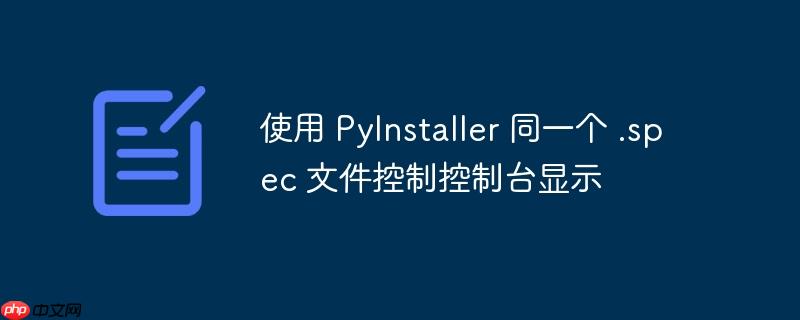
本文介绍了如何使用 PyInstaller 的同一个 .spec 文件,根据不同构建环境(例如开发分支、发布候选版本和最终发布版本)灵活控制控制台的显示与隐藏。核心在于利用 PyInstaller 6.0.0 及以上版本提供的参数传递功能,修改 .spec 文件中的 console 属性。通过这种方式,可以避免维护多个 .spec 文件,确保不同构建版本的输出一致性,同时方便调试。
利用 PyInstaller .spec 文件动态控制控制台显示
在开发 PyQt5 应用时,我们通常希望最终发布版本不显示控制台窗口,而在开发和调试阶段则需要显示控制台以便查看输出信息。如果使用 PyInstaller 打包应用,并且希望使用同一个 .spec 文件来构建不同版本,就需要一种机制来动态控制控制台的显示与隐藏。
PyInstaller 版本要求
实现此功能需要 PyInstaller 6.0.0 或更高版本。早期版本不支持向 .spec 文件传递参数。如果你的 PyInstaller 版本低于 6.0.0,请先升级:
pip install --upgrade pyinstaller
修改 .spec 文件
关键在于修改 .spec 文件,使其能够接收外部参数来控制 console 属性。以下是一个示例 .spec 文件:
# -*- mode: python ; coding: utf-8 -*- block_cipher = None a = Analysis( ['your_script.py'], pathex=[], binaries=[], datas=[], hiddenimports=[], hookspath=[], hooksconfig={}, runtime_hooks=[], excludes=[], win_no_prefer_redirects=False, win_private_assemblies=False, cipher=block_cipher, noarchive=False, ) pyz = PYZ(a.pure, a.zipped_data, cipher=block_cipher) exe = EXE( pyz, a.scripts, a.binaries, a.zipfiles, a.datas, [], name='your_application', debug=False, bootloader_ignore_signals=False, strip=False, upx=True, upx_exclude=[], runtime_tmpdir=None, console=True, # 默认显示控制台 disable_windowed_traceback=False, argv_emulation=False, target_arch=None, codesign_identity=None, entitlements_file=None, )
要实现动态控制,需要将 console 属性的值改为从外部参数获取。修改后的 .spec 文件如下:
# -*- mode: python ; coding: utf-8 -*- block_cipher = None a = Analysis( ['your_script.py'], pathex=[], binaries=[], datas=[], hiddenimports=[], hookspath=[], hooksconfig={}, runtime_hooks=[], excludes=[], win_no_prefer_redirects=False, win_private_assemblies=False, cipher=block_cipher, noarchive=False, ) pyz = PYZ(a.pure, a.zipped_data, cipher=block_cipher) exe = EXE( pyz, a.scripts, a.binaries, a.zipfiles, a.datas, [], name='your_application', debug=False, bootloader_ignore_signals=False, strip=False, upx=True, upx_exclude=[], runtime_tmpdir=None, console=kwargs.get('console', True), # 从 kwargs 获取 console 值,默认为 True disable_windowed_traceback=False, argv_emulation=False, target_arch=None, codesign_identity=None, entitlements_file=None, )
使用命令行参数控制
现在,可以使用 PyInstaller 的命令行参数来控制 console 属性。
-
显示控制台 (Debug/Release Candidate):
pyinstaller your_spec_file.spec --console=True
-
隐藏控制台 (Final Release):
pyinstaller your_spec_file.spec --console=False
注意事项
- 确保 .spec 文件中的 your_script.py 替换为你的主程序文件。
- kwargs.get(‘console’, True) 确保在没有传递 console 参数时,默认显示控制台。可以根据需要修改默认值。
- 这种方法避免了维护多个 .spec 文件,简化了构建流程。
- 建议在构建脚本中使用环境变量或配置文件来设置 –console 参数,以便在不同构建环境中自动切换。
总结
通过利用 PyInstaller 6.0.0 及以上版本提供的参数传递功能,可以轻松地使用同一个 .spec 文件来控制控制台的显示与隐藏,从而方便开发和调试,并确保最终发布版本的输出一致性。 这种方法提高了构建流程的灵活性和可维护性。


